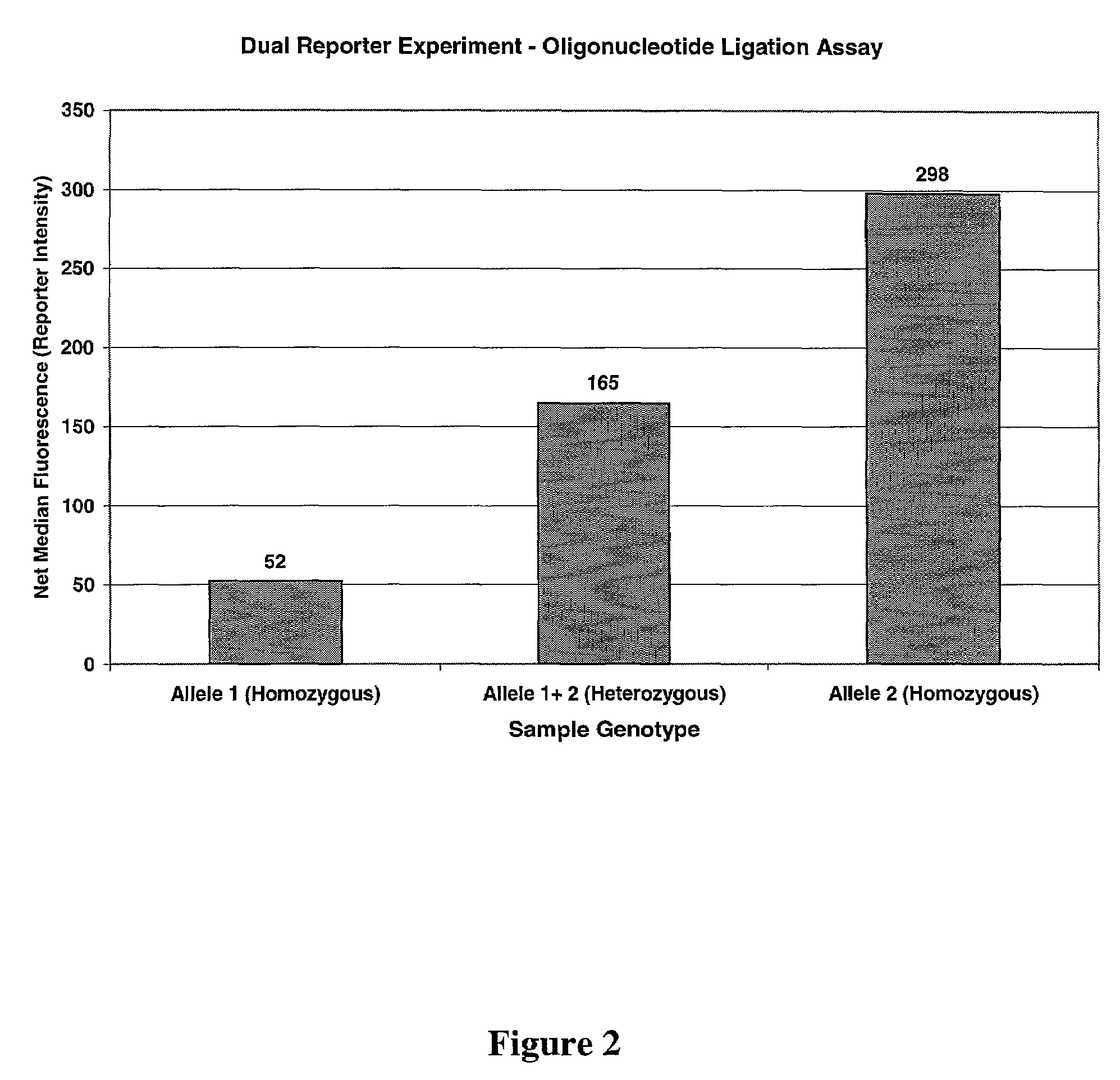Multiple reporter read-out for bioassays
a reporter and bioassay technology, applied in the field of multiple reporter readout for bioassays, can solve the problems of inability to measure more than a few distinct parameters or analytes simultaneously, methods that are not suitable for automated analysis of multiple mutations or multiple samples, and the difficulty of measuring multiple labels simultaneously, so as to reduce the accuracy and increase the detection limit
- Summary
- Abstract
- Description
- Claims
- Application Information
AI Technical Summary
Benefits of technology
Problems solved by technology
Method used
Image
Examples
example 1
Labeling Oligonucleotide Probes
[0074]The probe design is dictated by the location of the polymorphism or mutation. Generally, the probe is designed so that the polymorphic site hybridizes near the center of the probe. This is because mismatches near the ends of oligonucleotides tend not to be as disruptive to hybridization. Probe melting temperatures (Tm) are estimated by standard procedures like Primer Express™ primer design software (PE Applied Biosystems), which uses the “nearest neighbor” algorithm. A separate probe must be synthesized for each of the two alleles, one labeled with one fluorescent dye and the other labeled with another fluorescent. The length of each probe is adjusted so that both probes have a similar estimated Tm. One specific requirement for fluorogenic probes is that there be no G at the 5′ end. This is because a G adjacent to the reporter dye quenches reporter fluorescence somewhat even after cleavage. Finally, probes can be derived from either strand.
[0075]...
example 2
Alternative Labeling Approaches
[0085]Random prime labeling is a common method for labeling nucleic acids. This technique relies on a mixture of random primers, usually six to 10 nucleotides long, to prime DNA synthesis in vitro along any double-stranded DNA template. The Klenow fragment of DNA polymerase I is the enzyme used most frequently to synthesize the labeled DNA, but some novel polymerases are also available. Developed initially using 32P-dATP or 32P-dCTP, random prime labeling can also incorporate nucleotides tagged with 3H, 35S, 33P, and 125I into the newly synthesized probes. Nonradioactive nucleotides such as fluorescein-11-dUTP or biotin-14-dCTP are preferable labels. End-labeling reactions designed to attach tagged nucleotides to DNA, RNA, or oligonucleotides form the basis of several commercially available products. Terminal deoxynucleotidyl transferase labels nucleic acids at the 3′ end and is included in many products developed primarily for labeling oligonucleotide...
example 3
Detection of Sequence (Allele) Variations in a Nucleic Acid Sample
[0094]The method of the invention, which can be used to detect sequence variations in any nucleic acid sample, is demonstrated for the purpose of illustration, in the example set forth for the human BRCA1 gene. The BRCA1 gene is approximately 100,000 base pairs of genomic DNA encoding the 1836 amino acid BRCA1 protein. The sequence is divided into 24 separate exons. Exons 1 and 4 are noncoding and are not part of the final functional BRCA1 protein product. Each exon consists of 200-400 bp, except for exon 11 which contains about 3600 bp. The sequence for the coding region of the human BRCA1 gene can be found in GENBANK (e.g., AF005068 [gi:2218153]) or in the U.S. Pat. No. 6,048,689.
[0095]White blood cells are collected from the patient and genomic DNA is extracted according to well-known methods. The genomic DNA is used as a template to amplify a separate DNA fragment encompassing the site of each of the eight mutatio...
PUM
| Property | Measurement | Unit |
|---|---|---|
| emission wavelengths | aaaaa | aaaaa |
| emission wavelengths | aaaaa | aaaaa |
| infrared wavelengths | aaaaa | aaaaa |
Abstract
Description
Claims
Application Information
 Login to View More
Login to View More - R&D
- Intellectual Property
- Life Sciences
- Materials
- Tech Scout
- Unparalleled Data Quality
- Higher Quality Content
- 60% Fewer Hallucinations
Browse by: Latest US Patents, China's latest patents, Technical Efficacy Thesaurus, Application Domain, Technology Topic, Popular Technical Reports.
© 2025 PatSnap. All rights reserved.Legal|Privacy policy|Modern Slavery Act Transparency Statement|Sitemap|About US| Contact US: help@patsnap.com


